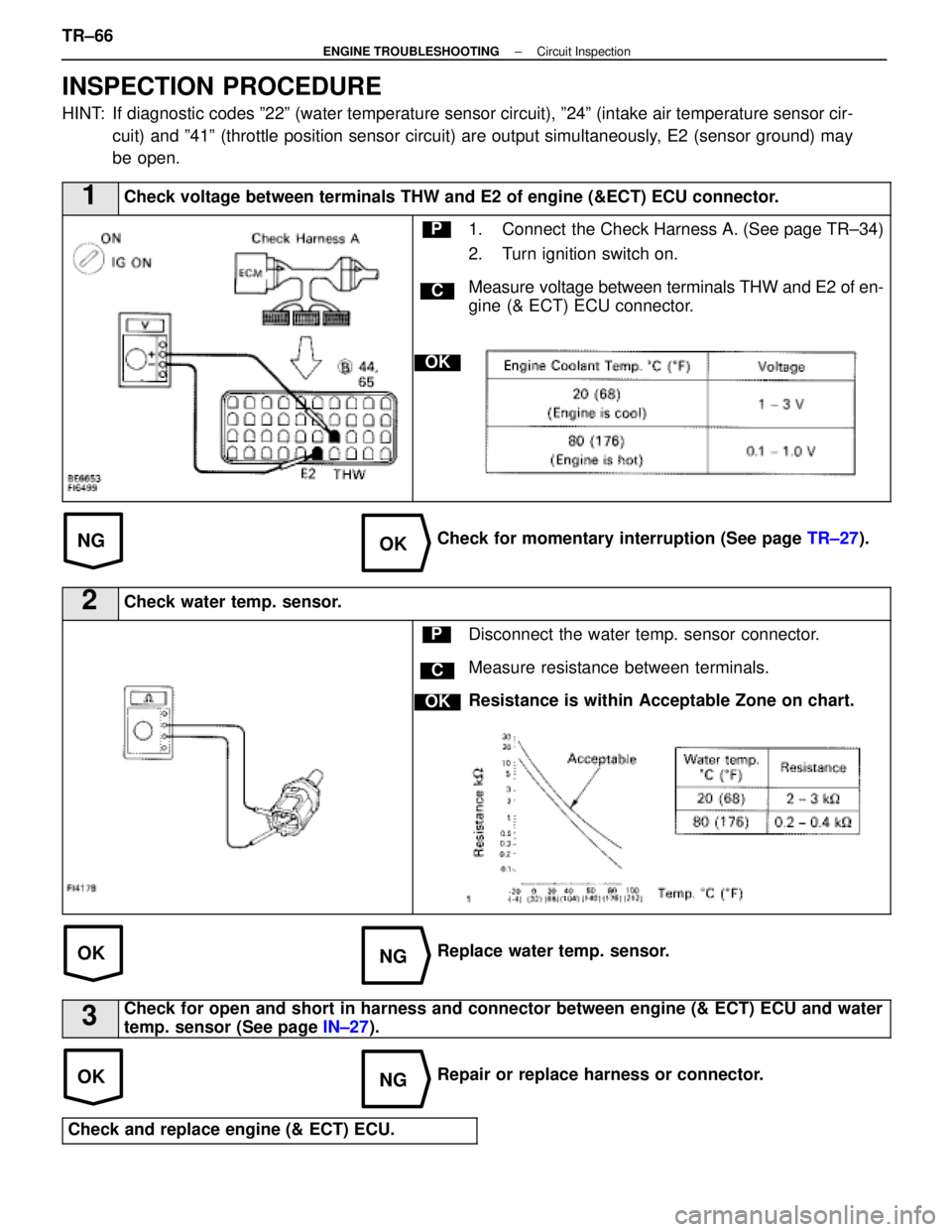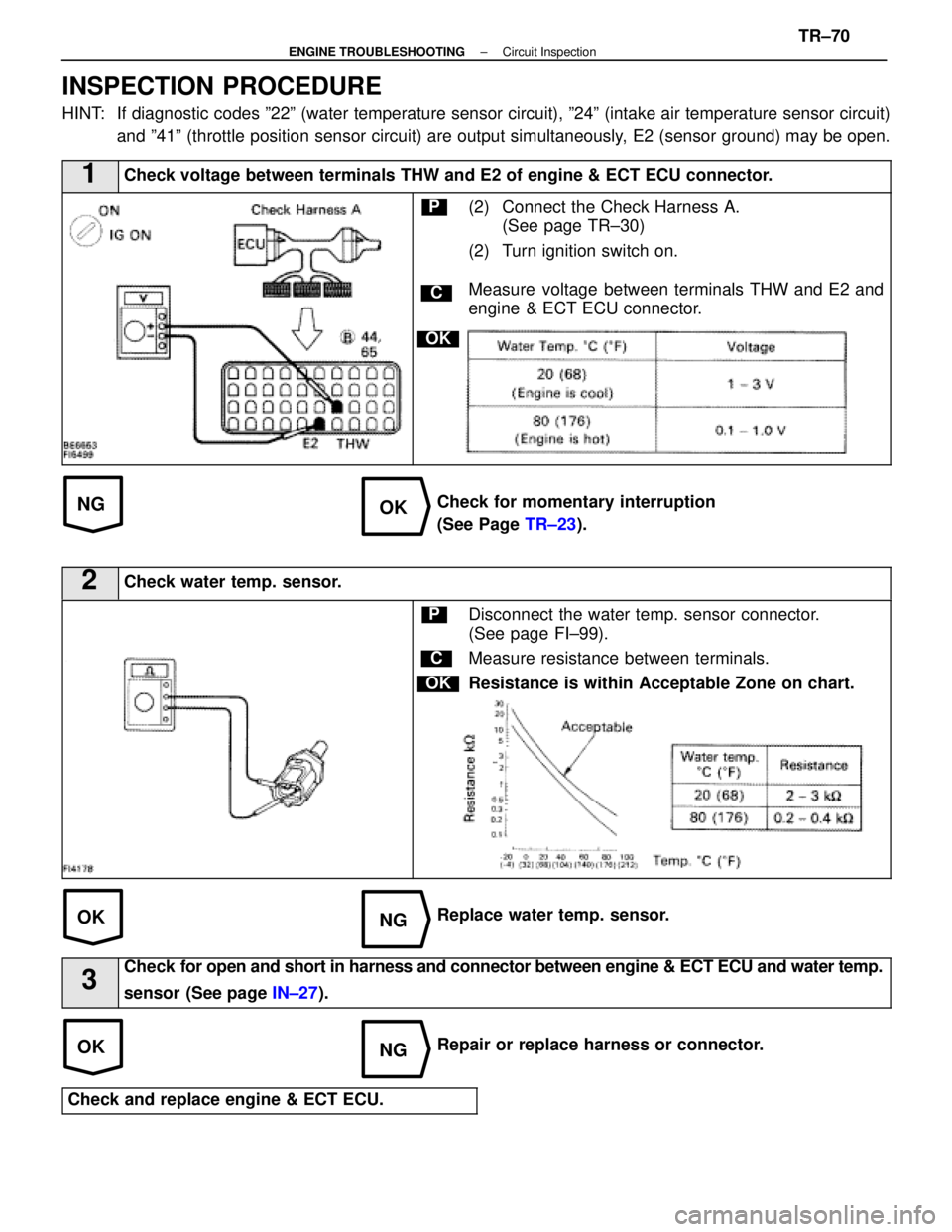Page 3468 of 4087
DIAGNOSTIC CHART
HINT: If diagnostic codes º22º (water temperature sensor circuit), º2\
4º (intake air temperature sensorcircuit) and º41º (throttle position sensor circuit) are output\
simultaneously, E2 (sensor ground)
may be open.
Check voltage of sensor.Check for momentary
interruption (See page TR±27).
Replace water temp. sensor.
Repair or replace harness or
connector.Check for open and short in harness and
connector between ECU and water temp.
sensor.
Check resistance of sensor.
Check and replace ECU.
WIRING DIAGRAM
aa
±
ENGINE TROUBLESHOOTING Circuit InspectionTR±65
WhereEverybodyKnowsYourName
Page 3469 of 4087

NGOK
OKNG
OKNG
INSPECTION PROCEDURE
HINT: If diagnostic codes º22º (water temperature sensor circuit), º2\
4º (intake air temperature sensor cir-cuit) and º41º (throttle position sensor circuit) are output simultan\
eously, E2 (sensor ground) may
be open.
1Check voltage between terminals THW and E2 of engine (&ECT) ECU connec\
tor.
C
OK
P1. Connect the Check Harness A. (See page TR±34)
2. Turn ignition switch on.
Measure voltage between terminals THW and E2 of en-
gine (& ECT) ECU connector.
Check for momentary interruption (See page TR±27).
2Check water temp. sensor.
C
OK
PDisconnect the water temp. sensor connector.
Measure resistance between terminals.
Resistance is within Acceptable Zone on chart.
Replace water temp. sensor.
3Check for open and short in harness and connector between engine (& ECT\
) ECU and water
temp. sensor (See page IN±27).
Repair or replace harness or connector.
Check and replace engine (& ECT) ECU.
TR±66±
ENGINE TROUBLESHOOTING Circuit Inspection
WhereEverybodyKnowsYourName
Page 3470 of 4087

Diag. Code 22Water Temp. Sensor Circuit
CIRCUIT DESCRIPTION
The water temperature sensor senses the coolant tem-
perature. A thermistor built in the sensor changes the
resistance value according to the coolant temperature.
The lower the coolant temperature, the greater the
thermistor resistance value, and the higher the coolant
temperature, the lower the thermistor resistance value
(See Fig. 1.).
The water temperature sensor is connected to the ECU
(See next page). The 5 V power source voltage in the
ECU is applied to the water temperature sensor from the
terminal THW via a resistor R. That is, the resistor R and
the water temperature sensor are connected in series.
When the resistance value of the water temperature
sensor changes in accordance with changes in the cool-
ant temperature, the potential at the terminal THW also
changes. Based on this signal, the ECU increases the
fuel injection volume to improve driveability during cold
engine operation. If the ECU records the diagnostic
code 22, it operates the fail safe function, keeping the
coolant temperature at a constant 80 5C (176 5F).
±
ENGINE TROUBLESHOOTING Circuit InspectionTR±68
WhereEverybodyKnowsYourName
Page 3471 of 4087
DIAGNOSTIC CHART
DIAGNOSTIC
CHART
HINT: If diagnostic codes º22º (water temperature sensor circuit), º\
24º (intake air temperature sensorcircuit) and º41º (throttle position sensor circuit) are output\
simultaneously, E2 (sensor ground)
may be open.
WIRING DIAGRAM
Check and replace ECU. Repair or replace harness or con-
nector.
Replace water temp. sensor.
Check voltage of sensor.
Check resistance of sensor.
Check for open and short in harness and
connector between ECU and water temp. sensor. Check for momentary interruption
(See page
TR±23).
TR±69±
ENGINE TROUBLESHOOTING Circuit Inspection
WhereEverybodyKnowsYourName
Page 3472 of 4087

NGOK
OKNG
OKNG
INSPECTION PROCEDURE
HINT: If diagnostic codes º22º (water temperature sensor circuit), º\
24º (intake air temperature sensor circuit)and º41º (throttle position sensor circuit) are output simultane\
ously, E2 (sensor ground) may be open.
1Check voltage between terminals THW and E2 of engine & ECT ECU connector\
.
C
OK
P(2) Connect the Check Harness A.(See page TR±30)
(2) Turn ignition switch on.
Measure voltage between terminals THW and E2 and
engine & ECT ECU connector.
Check for momentary interruption
(See Page TR±23).
2Check water temp. sensor.
C
OK
PDisconnect the water temp. sensor connector.
(See page FI±99).
Measure resistance between terminals.
Resistance is within Acceptable Zone on chart.
Replace water temp. sensor.
3
Check for open and short in harness and connector between engine & ECT ECU and\
water temp.
sensor (See page IN±27).
Repair or replace harness or connector.
Check and replace engine & ECT ECU.
±
ENGINE TROUBLESHOOTING Circuit InspectionTR±70
WhereEverybodyKnowsYourName
Page 3474 of 4087

Diag Code 25 26
Air±Fuel Ratio Lean Malfunction
Diag. Code 25, 26
Air±Fuel Ratio Rich Malfunction
CIRCUIT DESCRIPTION
Refer to page TR±62 for the circuit description.
Code No.
Diagnostic Code Detecting SystemTrouble Area
(1) Main oxygen sensor voltage is 0.45 V or less (lean) for 90 sec. under conditions
(a) and (b).
(2 trip detection logic)
*2
(a) Coolant temp.: 70 °C (158 °F)
or more.
(b) Engine speed: 1,500 rpm or more.
� Open or short in main oxygen sensor
circuit
� Main oxygen sensor
� Ignition system
� ECU
25
(2)*1 Difference of air±fuel ratio feedback
compensation value between front (No.
1 3 cylinders) and rear (No. 4 6
cylinders) is more than 15 percentage
for 20 sec. or more under conditions (a)
and (b).
(2 trip detection logic)
*2
(a) Engine speed: 2,000 rpm or more.
(b) Coolant temp.: Between 60 °C
(140 °F) and 95 °C (203 °F).
� Open and short in injector circuit.
� Fuel line pressure (injector leak, blockage)
� Mechanical system malfunction (skipping
teeth of timing belt)
� Ignition system
� Compression pressure (foreign object
caught in valve)
� Air flow meter (air intake)
� ECU
(3)*1 Engine speed varies by more than 15
rpm over the preceding crank angle period
during a period of 20 sec. or more under
conditions (a) and (b).
(2 trip detection logic)
*2
(a) Engine speed: Idling
(b) Coolant temp.: Between 60 °C
(140 °F) and 95 °C (203 °F).
� Open and short in injector circuit.
� Fuel line pressure (injector leak, blockage)
� Mechanical system malfunction (skipping
teeth of timing belt)
� Ignition system
� Compression pressure (foreign object
caught in valve)
� Air flow meter (air intake)
� ECU
26*1
(1) Difference of air±fuel ratio feedback
compensation value between front (No. 1
3 cylinders) and rear (No.4 6 cylinders) is
more than 15 percentage for 20 sec. or
more under conditions (a) and (b).
(2 trip detection logic)
*2
(a) Engine speed: 2,000 rpm or more.
(b) Coolant temp.: Between 60 °C
(140 °F) and 95 °C (203 °F).
� Open and short in injector circuit.
� Fuel line pressure (injector leak, blockage)
� Mechanical system malfunction (skipping
teeth of timing belt)
� Ignition system
� Compression pressure (foreign object
caught in valve)
� Air flow meter (air intake)
� ECU
261
(2) Engine speed varies by more than 15
rpm over the preceding crank angle peri-
od during a period of 20 sec. or more un-
der conditions (a) and (b).
(2 trip detection logic)
*2
(a) Engine speed: Idling
(b) Coolant temp.: Between 60 °C
(140 °F) and 95 °C (203 °F).
� Open and short in injector circuit.
� Fuel line pressure (injector leak, blockage)
� Mechanical system malfunction (skipping
teeth of timing belt)
� Ignition system
� Compression pressure (foreign object
caught in valve
� Air flow meter (air intake)
� ECU
*1: Only for USA specification vehicles.
*2: See page TR±25.
TR±70
±
ENGINE TROUBLESHOOTING Circuit Inspection
WhereEverybodyKnowsYourName
Page 3476 of 4087
DIAGNOSTIC CHART
Check voltage of terminal VF.
Repair or replace harness or
connector.
Repair or replace.
Repair or replace.
Replace main oxygen sensor.
Repair or replace.
Repair or replace.
Replace main oxygen sensor.
Check voltage of terminal OX.
Check for open and short in harness and
connector.
Check each item found to be a possible
cause of problem.
Check compression.
Does malfunction disappear when a good
main oxygen sensor is installed?
Check and replace ECU.
Check each item found to be a possible
cause of problem.
Check compression.
Does malfunction disappear when a good
main oxygen sensor is instaled?
Check and replace ECU.
NG Type II
NG Type I
WIRING DIAGRAM
Refer to page TR±62 for the WIRING DIAGRAM.
TR±72
±
ENGINE TROUBLESHOOTING Circuit Inspection
WhereEverybodyKnowsYourName
Page 3477 of 4087
NG
Type I
NG
Type II
NGOK
INSPECTION PROCEDURE
1Check voltage between terminals VF1, VF2 and E1 of check connector.
C
P
Cau-tion
1. Warm up engine at normal operating temperature
2. Connect terminals TE1 and E1 of check connector.
3. Connect positive prove to terminal VF1, VF2 and
negative prove to terminal E1 of check connector.
1. Warm up the oxygen sensor by running engine at 2,500 rpm for about 2 minutes.
2. Then, maintaining engine at 2,500 rpm, count how many times needle of voltmeter fluctuates between
0 and 5 V.
Go to step �.
2Check voltage between terminals OX1, OX2 and E1 of check connector.
C
OK
Hint
PWarm up engine at normal operating temperature.
Measure voltage between terminals OX1, OX2 and E1
of check connector when engine is suddenly raced to
full throttle.
The voltage should be 0.5 V or higher at least once.
Perform inspection within 1 second.
Go to step �.
±
ENGINE TROUBLESHOOTING Circuit InspectionTR±73
WhereEverybodyKnowsYourName